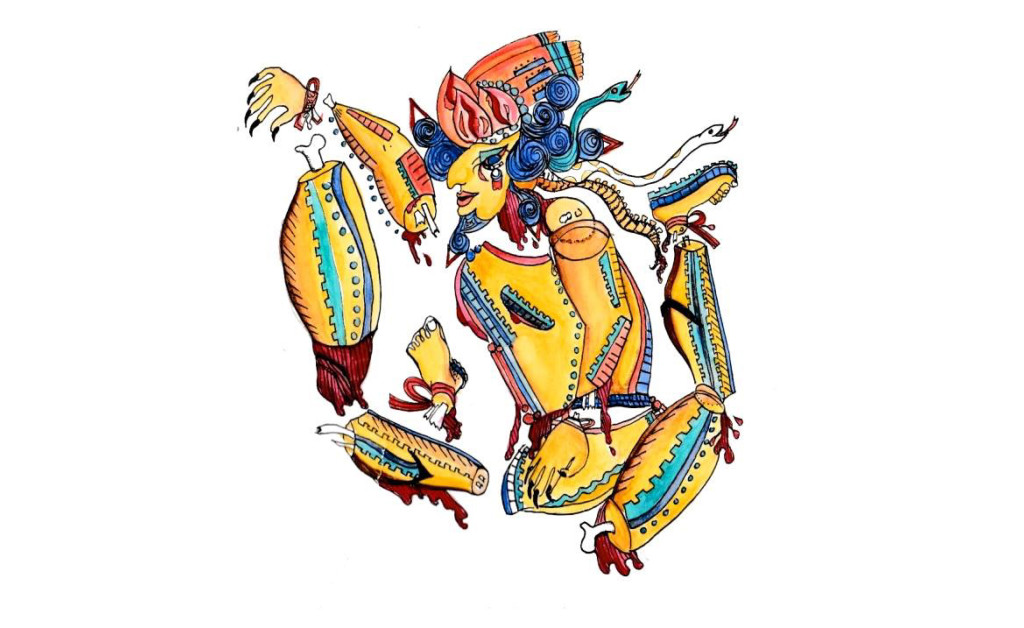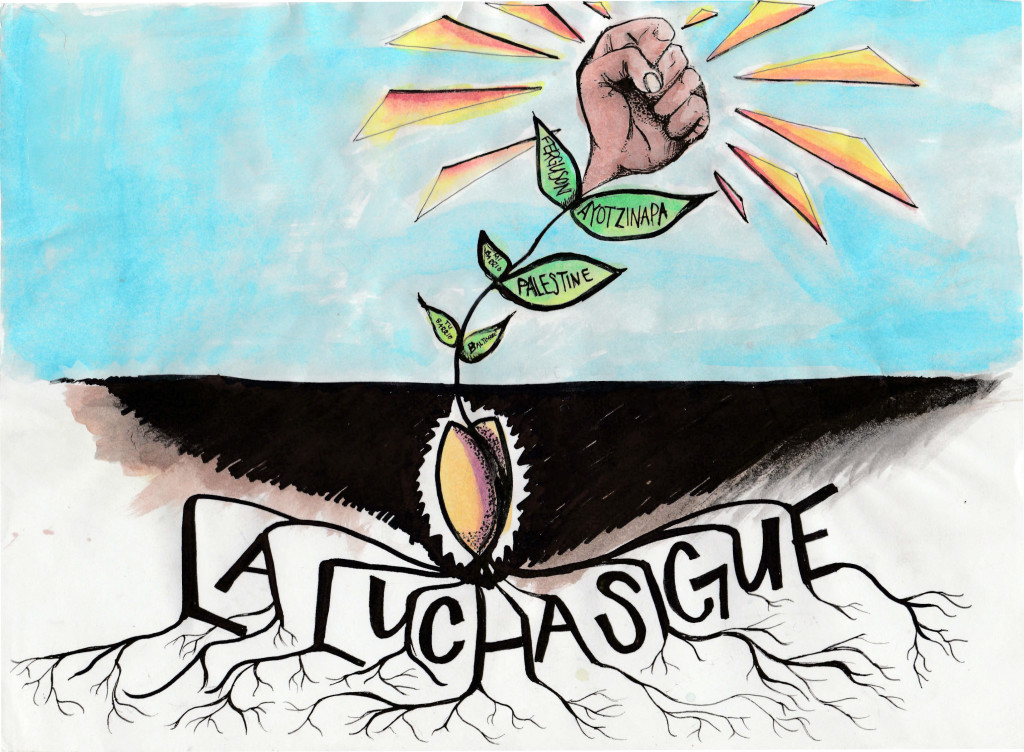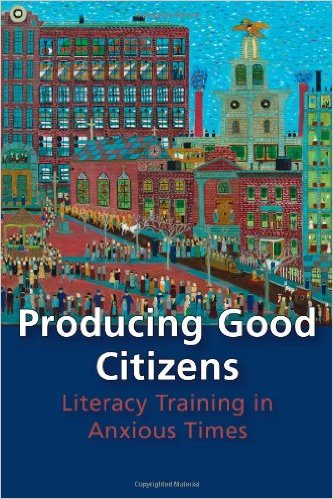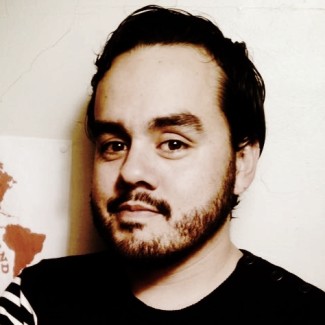Xicano Indigeneity & State Violence: A Visual/Textual Dialogue
“I am in daily search of these acts of remembering who we once were, because I believe they will save our pueblos from extinction…It is my right to remember.” ~ Cherríe Moraga
Histories recounting the “development” of Mexico and the United States do not typically centralize the experiences of Indigenous people. We are overwritten, present only through our absence from colonial narratives.1 So we listen to those absences. We feel the shape of the silence they produce, and we make things to fit that shape—paintings, frijoles, stories, songs, tamales, poems and sugar skulls. We use them to remember who we once were, for as Xicana-Indígena elders like Cherríe Moraga have shown, it is in remembering our past that we will be able to avoid the extinction of our future.
The “we” in this essay is two people: one a Xicano organizer and musician (Santos), the other a Xicana-Boricua organizer and visual artist (Angélica). We decided to collaborate on this piece, using two images created by Angélica to prompt a written correspondence between us about Xicano Indigeneity—the idea of Xicanos as Indigenous people—in relation to state violence. As we exchanged ideas in response to these images, two questions continuously arose for us, which we think will also be helpful for readers to keep in mind as you go: In what ways does Indigenous social justice work differ from other kinds of social justice work? And what are some of the complications in building solidarity between social movements that focus on a diversity of issues? While we do attempt to answer these questions in concrete ways, our conversation is more reflective than it is analytical. In taking this approach, we hope to generate further inquiry into the relationship between Indigeneity, social justice, and cross-cultural solidarity.

Angélica: This illustration of Moon Goddess Coyolxauhqui (see Fig. 1) was born of a need to explore feminine figures within Latino/Indigenous culture, particularly those who are often vilified and silenced in mythology (i.e., Medusa, Malinche, Erzulie Dantor).
As I have heard them, stories say that Coyolxauhqui led an attack against her mother, Coatlicue, who had become pregnant by a mortal. Convinced this new child would destroy the order of their kingdom, Coyolxauhqui and her star siblings planned a rebellion. Moments before the strike, Huitzilopochtli, God of Sun & War, burst from Coatlicue’s womb fully formed, ripped Coyolxauhqui into pieces and scattered her across the sky, where she became the moon.
Coyolxauqui’s story is important to me because it speaks to the way that state violence carries on the colonial tradition of situating masculinity against femininity, a binary that causes violence against (Indigenous) womyn, trans and gender non-conforming folks. This piece is inspired by people like this who continue to survive unapologetically.
Santos: I think it’s worth mentioning that a similar image of Coyolxauqui appears on a stone that was found in 1978 in the Aztec capital city of Tenochitlan (Scolieri 91-93). I’ve heard that after Huizilopochtli had decapitated Coyolxauqui, he sent her body falling down the side of a mountain, and to commemorate this dramatic event, the Aztecs created the stone depicting Coyolxauqui’s dismembered body and placed it at the base of a temple.
So while you say that Coyolxauqui was interested in preserving “the order of their kingdom,” she has in other ways been immortalized as a symbol of what happens to people who attempt to rebel against the status quo—they are literally disposed of by those in power. The Aztecs surely had their own uses for the mythologies of Huizilopochtli and Coyolxauqui, but our contemporary activist interpretations of these two figures undoubtedly reflect a need to acknowledge the ongoing violence being enacted against women in our own society, to bring attention to rampant police brutality, and to connect these issues to the many other instances of state-sanctioned violence that we see happening today.
However, in using the image and story of Coyolxauhqui, you also highlight how “state violence carries on the colonial tradition,” which I take to mean that you find it important to note that “the state” should be understood as an iteration of colonialism. Is that right?
Angélica: Yes. In my mind, the state emerges from colonialism, and this piece for me represents that consequential rupture of an Indigenous understanding of gender and spirituality.2 Huizilopochtli (the central masculine character) literally bursts from his mother’s womb, which symbolizes the ways that colonialism disrupted the circularity of Indigenous ways of being in the world.
As I was creating this piece I thought about my experiences with Christianity in the US and how worship and faith tended to derive spiritual power primarily from masculine figures. Women, and especially women of color, were locked out of positions of spiritual leadership within the parish, and I don’t think it goes deep enough to say that issues like this are the result of the state—as in “nation-states”—exerting power over people.
Santos: I agree that the scatteredness of both your drawing and the story of Coyolxauqui seem to speak to a broad colonial rupture of Indigenous life, and I think they also speak very specifically to the experience many Xicanos have as detribalized Indigenous people. Because of the many layers of colonialism we have experienced and continue to experience—by the Spanish Empire, by the Mexican state, and by the US-Mexico border—many of us have lost connection with specific tribes, or we consequently come from many different tribes.
So being Xicano can also mean that we are living a severed, chaotic, and disorienting existence, because we often don’t even know how to name ourselves. Colonization has distorted our historical narratives to the point that we look in the mirror today and we do not recognize what we see; we do not recognize our own power. It’s a sort of cultural dismemberment that I recognize within the physical dismemberment of your depiction of Coyolxauqui.
Angélica: Recognizing our power is an essential step in building long-term movements, so it makes me wonder how to go about splitting time between different types of movement work, between the different communities we belong to. That’s sort of like being able to recognize something powerful in other people at the same time.
Santos: Well in terms of splitting time between the different communities we belong to, and to building intersectional social movements in general, I think the ability to see one another in complex ways is vital. I mean don’t expect other people to spend all of their time learning about Xicano history, but I do think it’s essential for us to at least try and know something about how our various cultures are positioned in relation to one another. In this regard, I think Cherríe Moraga rightly encourages non-Indigenous people to think about how Indian and Xicano issues differ from other kinds of social justice issues, because as she puts it, “the culturally genocidal detribalization of Xicanas and Xicanos and other Indigenous peoples has occurred in part because Indigenous sovereignty has been virtually eliminated from the national discourse on both sides of the border” (125). So even social justice workers have the capacity to contribute to the erasure of Indigenous cultures, because failing to recognize our differences is also a failure to recognize our sovereignty.
In a similar way, I can’t really know what “liberation” means either without knowing how colonialism ties together the struggles of non-Indigenous people of color, the working class, women, queer and disabled folks. Those struggles look different for all of us, but we’ve got to try and incorporate some of that complexity into our daily work if we’re going to build real solidarity.

Angélica: We’ve already talked a little bit about solidarity, so I’m curious to hear what you see happening in this image?
Santos: The plant in your painting (see Fig. 2) depicts the way that various social justice movements live and grow together. I immediately recognize the fist as a symbol of social justice, and because it is brown, I think of Chicano Power in particular. The leaves of the plant represent various parts of a larger struggle—some would say it is a struggle against state violence, but I prefer to name it as a struggle against colonialism. On the leaves I see Ferguson, Ayotzinapa, and Palestine most clearly.
Seeing this image also makes me wonder what it is that connects these various struggles to one another? This question comes up frequently in my own academic research and community organizing, as I have increasingly felt a responsibility to focus on Xicano-specific issues. Part of the reason for this is that for much of my life I didn’t have access to my own history—that is, Mexican/Xicano history wasn’t taught to me in school—so now I feel a moral and cultural obligation to bring Xicano history to our youth in ways that I never had the opportunity to engage when I was growing up.
So if we are talking about building a broad, cohesive liberation movement, the issue becomes about how to simultaneously be active supporters of adjacent movements while still also fulfilling the cultural and social commitments we have to our own people. That’s what I like about this image, too. It shows that our various struggles are connected without necessarily having the burden of articulating how they stay connected. It just makes visible that, for better or worse, our respective growth is dependent upon our collective survival.
Angélica: Yes, definitely. As a queer, mixed Xicana/Boricua, I think about the importance of cultivating my contribution to the work in a way that moves beyond disempowering applications of mestizaje, which ignore third-root ancestral ties to Africa. This not only physically/psychically connects me to other works, but it is a way to expand how I practice building futures that make room for these kinds of complexities.
This painting was inspired by the Mexican/Indigenous proverb “¿Nos enterraron sin saber que éramos semillas/They buried us without knowing we were seeds” and was created while witnessing the growth of uprisings in response to racially motivated state violence. While visual interpretations of the proverb were initially circulated to draw attention to the missing/murdered 43 students of Ayotzinapa, the sentiment translated well to the ongoing grassroots work occurring in places including Ferguson, Oakland, Palestine, and barrios across Turtle Island (the Americas).
The style of this piece is rooted in print-media styles associated with radical art movements—simple and bold imagery that can be easily replicated. Another iteration of the work includes blank leaves as a way to encourage personalization and to acknowledge the many facets of our collective struggle towards liberation for all of us, not just some of us.
Santos: So your design was created to be interactive and to allow people to fill in the blank leaves however they want. Conceptually, it reminds me of the work of the Just Seeds Artist Collective, and of Dylan Miner’s work more specifically. There’s a Youtube video where he talks about wanting to create art that exists out in the world and has a tangible function within social movements.
Visual art plays such an important role for activists because so much of our work is about figuring out how to condense complex messages down into something that can be seen/heard/felt almost instantaneously, and there is a lot of potential in visual imagery to accomplish this in efficient and powerful ways.
Angélica: Like you said earlier, we want to be in a place where we can see people as complex. It seems like there is potential for art to be a process of embracing disorder, a place to practice imagining life outside of colonialism.
Reflection
It has been important for us to include these two visual images as a guide for our discussion on Indigeneity, violence, and activism because the images themselves contain stories that cannot be precisely replicated through written text. We find in visual artwork a capability to cut across some of the obstacles to communication created by language and (especially academic) dialect: a dynamic not dissimilar to the way that storytelling3 circumvents some of the communicative obstacles created by other, perhaps more traditionally “academic,” genres of writing. We ground our attention to visual imagery and story, first and foremost, in our experiences as people who grew up in Xicano and Xicana-Boricua cultural settings, where these forms of communication were often privileged.
Because of the content of the artwork, many parts of our dialogue focus on issues related to state violence. Yet, we must admit that it is still often unclear to us exactly what some writers mean when using this term—“the state.” Sometimes it seems to refer specifically to federal governments, and other times to any formalized structure of governance that the author or speaker has in mind. Still other times, “the state” appears to be a stand-in term used to refer to any vague force of injustice. We would like to suggest that greater clarification is needed when using this term, if not only because we find that failing to do so can sometimes contribute to the erasure of Indigenous issues. Social justice efforts exclude the needs of Indigenous people when they are not intentional about recognizing the specificity of Indigenous social justice issues, which unlike other issues, are often rooted in sovereignty and claims to land. Discussing “the state” without also considering Indigeneity, then, cannot lead to a productive conversation that is truly inclusive of Xicano and Indian people,4 and will ultimately serve a reformist agenda.
Endnotes
- We draw from arguments and stories told by Thomas King in The Truth About Stories: A Native Narrative, as well as Cherríe Moraga’s work more generally, in advocating for the usefulness of personal narratives within scholarly writing. return
- Qwo-Li Drikill’s essay “Double-weaving two-spirit critiques: Building alliances between native and queer studies” is a helpful resource for understanding the importance of Indigeneity in conversations about race. return
- This idea is similar to Audre Lorde’s writing about “the erotic” in “Uses of the Erotic: The Erotic as Power.” return
- Here we borrow from Malea Powell’s “Listening to Ghosts: an alternative (non)argument” in the way we talk about absence/presence and Indigeneity. return
Works Cited
- Miner, Dylan A.T. “Dylan Just Seeds feature.” Video. YouTube. Posted 7 April 2010. Retrieved 28 June 2015. https://www.youtube.com/watch?v=oc_blJBKMNQ
- Moraga, Cherríe. A Xicana Codex of Changing Consciousness: Writings 2000-2010. Durham: Duke University Press, 2011. Print.
- Scolieri, Paul. “Coyolxauqui’s impact: Aztec historiography and the falling body.” Women & Performance: A Journal of Feminist Theory 14.1 (2008): 91-106. 2008. Web.
Cover Image Credit: Angélica De Jesús. Coyolxauhqui’s Unapologetic Survival. Ink and water color on mixed-media paper, 9 ½” x 11”, 2014.




 Santos F. Ramos is a Xicano organizer and a Doctoral student at Michigan State University, where he teaches writing with an emphasis on race & technology. His community-engaged research focuses on food sovereignty, Indigenous Rheotorics, and social justice organizing. He is also a huge fan of basketball, hip-hop, and sad Mexican love songs from back in the day.
Santos F. Ramos is a Xicano organizer and a Doctoral student at Michigan State University, where he teaches writing with an emphasis on race & technology. His community-engaged research focuses on food sovereignty, Indigenous Rheotorics, and social justice organizing. He is also a huge fan of basketball, hip-hop, and sad Mexican love songs from back in the day.  Angélica De Jesús is a queer Xicana/Boricua southern femme currently creating and organizing in the Midwest. She makes a living as a public health IT worker and makes trouble decolonizing medicine. Her research and artwork center around community health justice, mass incarceration and immigrant/Indigenous and LGBTQIA culture.
Angélica De Jesús is a queer Xicana/Boricua southern femme currently creating and organizing in the Midwest. She makes a living as a public health IT worker and makes trouble decolonizing medicine. Her research and artwork center around community health justice, mass incarceration and immigrant/Indigenous and LGBTQIA culture.